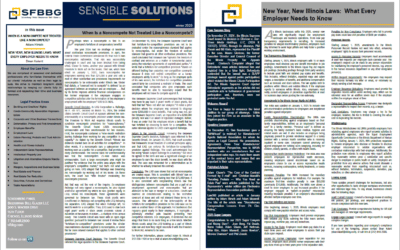On Nov. 25, 2019, the U.S. Supreme Court denied petitions for writs of certiorari seeking review of a U.S. Court of Appeals for the District of Columbia Circuit decision, allowing climate scientist Michael Mann’s defamation case to proceed against the National Review, the Competitive Enterprise Institute and two individuals.
The court’s denial of cert got widespread press, particularly as a consequence of Justice Samuel Alito’s dissent, in which he found that the case had “serious implications for the right to freedom of expression.” Multiple amicus briefs, from such diverse entities as the American Civil Liberties Union, the Washington Post and Fox News, had supported the defendants’ legal position, arguing that the statements involved in Mann’s lawsuit constituted nonactionable opinions.
However, under generally applied criteria for determining whether a statement constitutes verifiable fact vs. nonactionable opinion, and notwithstanding Justice Alito’s warnings about the circumvention of free speech, the denial of certiorari was appropriate.
The Basis of Mann’s Lawsuit
Mann, an authority on climate science, is Penn State University’s Distinguished Professor of Meteorology and director of its Earth System Science Center. Mann coauthored two scientific papers that statistically reported earth temperatures over a period of several centuries.
The data was collected from sources including growth rings of ancient trees and corals, sediment cores from ocean and lake bottoms, ice cores from glaciers, and cave sediment. Mann and his cohorts concluded that the rise in earth temperatures since the early 20th century was unprecedented, and positively correlated with higher carbon dioxide in the atmosphere from fossil fuel combustion.
The study showed that earth had been in a cooling period between 1050 and 1900, followed by a sharp temperature increase in the 20th century. Mann graphically depicted his findings showing the extreme and sudden rise in earth’s temperature in the shape of a hockey stick, which was met with grave concern by some and skepticism by others. Various subsequent studies validated the methodology underlying Mann’s conclusions.
In 2012, Rand Simberg published an article on OpenMarket.org, a blog published by the Competitive Enterprise Institute. That article compared Mann’s report with the Penn State sexual abuse scandal involving Jerry Sandusky, and concluded that Mann’s research constituted “hockey-stick deceptions”.
Simberg wrote:
Mann could be said to be the Jerry Sandusky of climate science, except for instead of molesting children, he has molested and tortured data in service of politicized science that could have dire consequences for the nation and planet.
Simberg added that emails he analyzed revealed that Mann engaged in “data manipulation” in order “to keep the blade on his famous hockey-stick graph.” Simberg further charged that Penn “covered up Mann’s heinous crimes and hid Mann’s academic and scientific misconduct.”
The other individual defendant, Mark Steyn, wrote an article published on defendant National Review’s blog “The Corner,” in which he quoted the above content from Simberg’s article and further charged that Mann was behind “the fraudulent climate-change hockey-stick graph.” He concluded:
If an institution is prepared to cover up systematic statutory rape of minors, what won’t it cover up? Whether or not he’s the “Jerry Sandusky of climate change,” he remains the Michael Mann of climate change, in part because his ‘investigation’ by a deeply corrupted administration was a joke.
The Defendants’ Motions to Dismiss
The defendants moved to dismiss Mann’s defamation complaint, claiming their statements constituted nonactionable opinions, and that the complaint constituted a strategic lawsuit against public participation, commonly known as a SLAPP suit.
In affirming the denial of the defendants’ motions to dismiss, the appeals court acknowledged Milkovich v. Loraine Journal Co.,[1] where the Supreme Court found that a pure statement of opinion is not actionable because it cannot be proven to be false.[2]
This defense is not without limits, however. The appeals court also recognized that
the First Amendment gives no protection to an assertion “sufficiently factual to be susceptible of being proved true or false,” even if the assertion is expressed by implication in a “statement of opinion.”[3]
In finding that the subject statements could not, as a matter of law, be found to constitute nonactionable opinion, the D.C. Circuit found “a jury could reasonably interpret Mr. Simberg’s article as asserting … Mann engaged in deceptive data manipulation and academic and scientific misconduct.”[4]
Why Mann’s Case Should Proceed in the District Court
Whether a statement alleged to be defamatory constitutes nonactionable opinion is traditionally determined through an analysis of factors first set forth by the D.C. Circuit in Ollman v. Evans.[5] State and federal courts across the country regularly cite Ollman in determining opinion issues in defamation cases.
Ollman identifies four factors to be analyzed under a totality of the circumstances test:
- The common usage or meaning of the specific language of the challenged statement and whether the statement has a precise core of meaning for which a consensus of understanding exists, or conversely, whether the statement is indefinite and ambiguous;
- The statement’s verifiability — whether the statement is capable of being objectively characterized as true or false;
- The context of the statement; and
- The broader context or setting in which the statement appears, and whether that context signals to the reader the likelihood of the statements constituting fact or opinion.
Pursuant to the Ollman totality of the circumstances test, Mann, if not a tie, weighs against finding the statements constitute nonactionable opinion. The statements were published on blogs, which by their nature, are forums for the free expression of ideas. However, that a statement is published within the context of a blog is not in and of itself determinative of whether or not a statement has factual content, is reasonably capable of objective verification or has a precise core of meaning.
Consider, for example the Illinois Supreme Court’s decision in Hadley v. Doe,[6] where a blog comment compared a local politician to a “Sandusky waiting to be exposed,” and noted that his front door had a view of a grammar school. Notwithstanding that the statements were made in a blog and were phrased in colorful language, the court found the poster “intended to convey the idea that Hadley was a pedophile or had engaged in sexual acts with children.”
Applying the totality of the circumstances test, the court held that the blog comments had a precise and readily understood meaning and were verifiable. The court observed, “while the internet is susceptible to hyperbole, exaggerations, and rhetoric, it is also a place where factual content is conveyed.”
Significantly, Simberg’s statements regarding Mann’s alleged “molestation and torture of data in service of politized science” suggests as fact that Mann manipulated and distorted scientific data to reach a politically expedient conclusion. Such a statement falls within defamation per se, as it conveys that Mann lacks integrity in his profession as a research scientist, and presented fraudulent data to further a political, not scientific, purpose.
Simberg further stated that Penn State covered up Mann’s wrongdoing and scientific misconduct. This statement amplifies Simberg’s other statement regarding Mann’s molestation and torture of data, and demonstrates that he was not merely speaking in loose, hyperbolic language.
As courts have found, although blog posts may signal an exchange of ideas and opinions, they can also be used as forums to advance factual and defamatory statements. Asserting that Mann engaged in data manipulation and deceptions can be reasonably viewed, in context, as relying on statements of fact.
Although these verifiable statements were amplified through colorful language, at their core, they can reasonably be interpreted as charging Mann with a lack of integrity and ethics as a research and climatological scientist. Accordingly, Mann is a case that the majority of the Supreme Court got right in denying certiorari.
This article can also be found published in Law 360. Click here for the printed version of this article.



